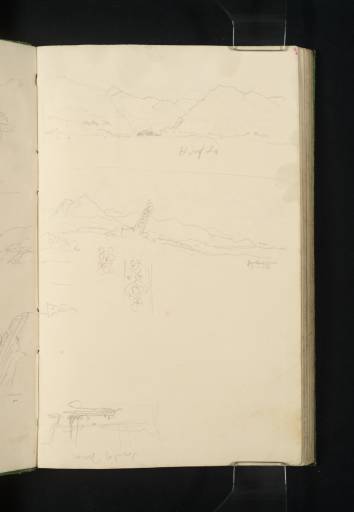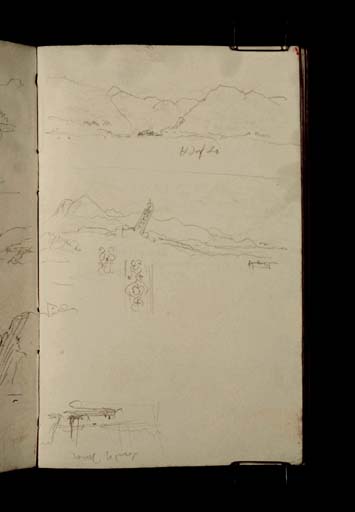Joseph Mallord William Turner The Head of Loch Long; The Keill Cross, Islay; and the Sound of Islay from Port Askaig 1831
Image 1 of 2
Joseph Mallord William Turner,
The Head of Loch Long; The Keill Cross, Islay; and the Sound of Islay from Port Askaig
1831
Joseph Mallord William Turner 1775–1851
Folio 86 Verso:
The Head of Loch Long; The Keill Cross, Islay; and the Sound of Islay from Port Askaig 1831
D26606
Turner Bequest CCLXX 86a
Turner Bequest CCLXX 86a
Pencil on white wove paper, 201 x 125 mm
Inscribed in pencil by Turner ‘Head of Lo’ upper centre, ‘Sound of Jura’ bottom left inverted
Inscribed in pencil by Turner ‘Head of Lo’ upper centre, ‘Sound of Jura’ bottom left inverted
Accepted by the nation as part of the Turner Bequest 1856
References
1909
A.J. Finberg, A Complete Inventory of the Drawings of the Turner Bequest, London 1909, vol.II, p.871, CCLXX 86a, as ‘ “Hd. Of Lo.,” “Chaple I.,” “Sound of Jura,” &c.’.
At the top of the page, and continuing at the left on folio 87 (D26607), is a sketch inscribed ‘Head of Lo’. David Wallace-Hadrill and Janet Carolan have recognised this as the head of Loch Lomond, as seen from a point on the loch near Tarbet.1 The hill above the inscription is Cruinn a’ Bheinn. Turner travelled the length of the loch by steamboat, stopping at Luss (folio 23; D26480) on his journey north before landing at Ardlui at the head of the loch where he made a sketch looking south (folio 52; D26538). For more information on Turner’s tour of Loch Lomond see Tour of Scotland for Scott’s Poetical Works 1831 Tour introduction.
The other two sketches on the page were made on the island of Islay in the Inner Hebrides. In the middle of the page is a sketch of a broken Gaelic cross standing at an angle, with mountains in the distance at the left and water straight ahead and at the right. This has been identified as the West Highland Cross Shaft, situated at the hamlet of Keills near Port Askaig at the east of the island.2 Turner passed Keills on his journey between Port Askaig and Loch Finlaggan (see folio 70 verso; D26675). The hills in the distance are therefore the Paps on the island of Jura with the Sound of Islay between the two islands. The top of the cross and the horizontal bar have been lost, leaving only the shaft which stands in the ground at an angle. Beneath the sketch Turner made two studies of the engraved designs on the cross. Both concentrate on the lower portion of the shaft where there are two scrolls back-to-back. A sketch opposite on folio 78 (D26607) is inscribed ‘Chapel Is[lay]’, and on folio 48 verso (D26531) there is a sketch inscribed ‘Churchyard Islay’, which is likely also to be of Keills.
The sketch at the bottom of the page, drawn with the sketchbook inverted, is inscribed ‘Sound of Jura’. Turner, it seems, did not travel through the sound of Jura, so this is likely to be a mistake, and probably shows the Sound of Islay. David Wallace-Hadrill and Janet Carolan have identified this as a view of the Sound from Port Askaig, a larger and more detailrd version of which is on folio 87. See folio 37 verso (D26509) for references to further sketches of the port.
Beneath the Keill sketch is the slight continuation of two sketches on folio 87.
Thomas Ardill
January 2010
How to cite
Thomas Ardill, ‘The Head of Loch Long; The Keill Cross, Islay; and the Sound of Islay from Port Askaig 1831 by Joseph Mallord William Turner’, catalogue entry, January 2010, in David Blayney Brown (ed.), J.M.W. Turner: Sketchbooks, Drawings and Watercolours, Tate Research Publication, December 2012, https://www


